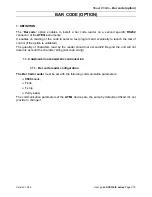
Orbit Reader 20
– User guide
Version 2.10
Orbit Research
Confidential and Proprietary Information
7
4
Automatic Translation
In addition to professionally transcribed titles, you may also use dynamic
translation to obtain braille.
Automatically translated braille may be appropriate for some forms of reading.
•
is a free audio information service, providing
downloadable Braille files of up-to-the-minute content from over 400
national, international, and state newspapers.
•
dynamically generates braille formatted files from the
titles in its library.
5
Translate Braille
•
is a full-featured transcription software package for
creating quality formatted braille.
•
provides a comprehensive solution for converting text
documents into accessible formats, including braille PEF (Portable
Embosser Format).
is a shortcut that adds braille to the Windows® Send To menu,
which can convert files on your computer into unformatted BRL (Braille Ready
Format) files.
6
Documentation Conventions
For consistency and clarity, this documentation uses the following conventions.
Braille keys are indicated by number. For example, if the documentation
indicates Dot 1, it shows: Dot 1.
If multiple braille keys are required, the documentation indicates those keys by
showing the numbers separated by a space like this: Dots 1 4.
When modifier keys are used, the documentation separates the modifiers from
the rest of the keys with a plus (+) sign like this: Space + Dot 1. Recall that
modifiers, like the Shift key on a regular QWERTY keyboard, are keys you hold
down while pressing another key. This modifies the effect of the pressed key. On
a braille keyboard, Space is often used as a modifier to alter the effect of the
input keys.
Key mnemonics are written in capital letters for emphasis but are typed in braille
lowercase (unless otherwise stated). When one key follows another, the two keys
are shown with a comma between them. For example, the command Select, M








































